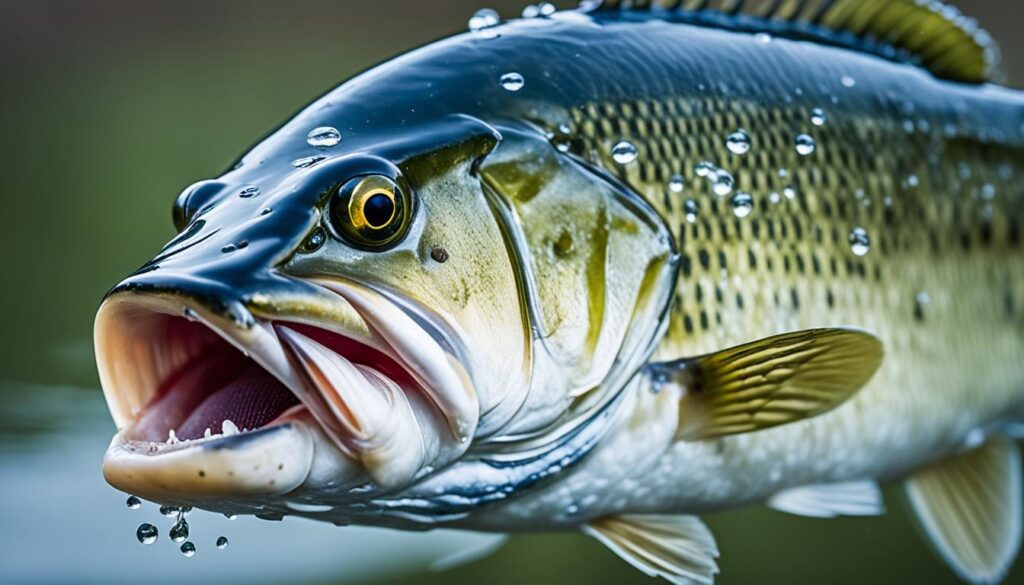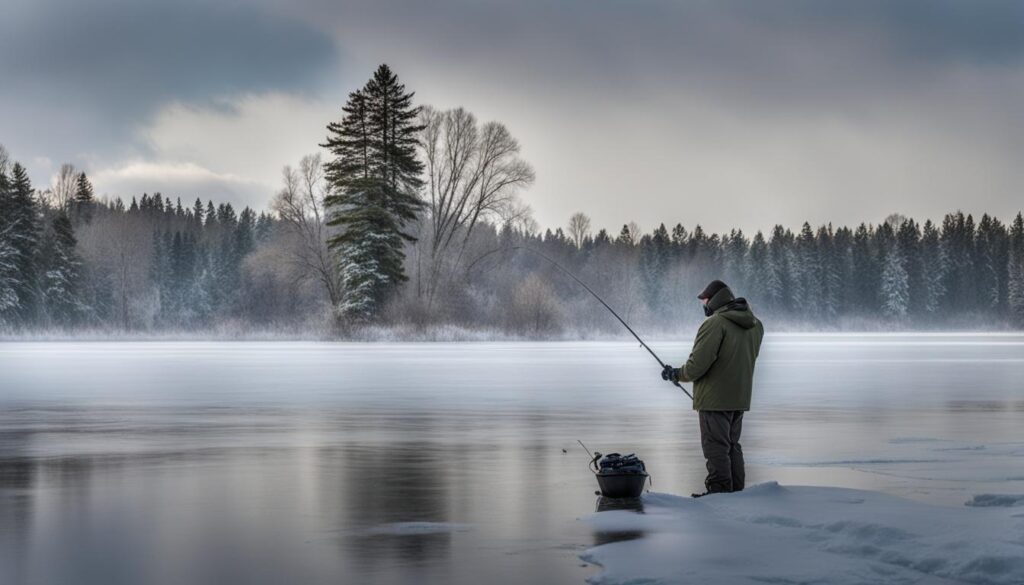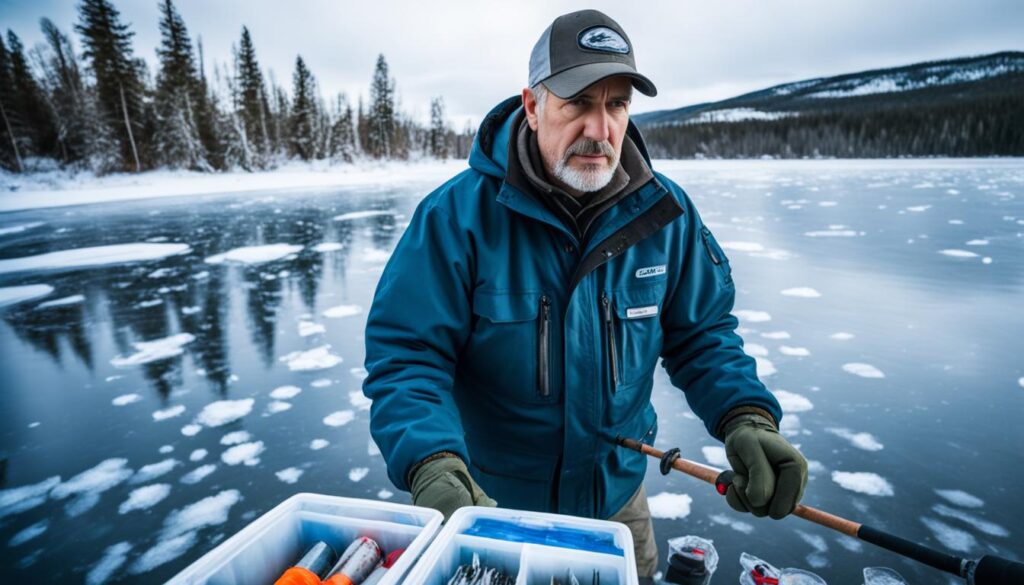Are you ready to find and catch heavyweight winter bass? Look no further! In this in-depth blueprint, we will provide valuable winter bass fishing tips, techniques, and strategies to help you succeed in your cold-weather fishing adventures. Whether you’re a seasoned angler or just starting, we’ve covered you with expert advice and insights.
When catching bass in winter, it’s essential to understand their behavior and adapt your approach accordingly. We’ll walk you through the best baits, proven techniques, and practical strategies to maximize your chances of landing those trophy-sized bass. Get ready to take your winter bass fishing to the next level!
Angler’s Essentials:
- Learn valuable winter bass fishing tips and techniques to enhance your success.
- Understand the behavior of winter bass and adjust your approach accordingly.
- Discover the best baits and strategies for targeting heavyweight bass during the colder months.
- Improve your skills in flipping, fly fishing, punching mats, and casting to isolated cover.
- Challenge and dispel common myths about bed fishing for winter bass.
Flipping Tips for Targeting Winter Bass
In the pursuit of winter bass, professional angler Brian Coleman shares valuable flipping tips to help anglers increase their success. Flipping is a tried-and-true technique that involves making precise presentations to visible, thick cover where bass seek refuge during the colder months.
When targeting winter bass, Coleman recommends the following flipping tips:
- Equip a Heavy-Action Rod: Selecting the right equipment is crucial for flipping. Opt for a heavy-action rod that provides the necessary power and sensitivity to handle heavyweight bass and control the lure’s movement.
- Use Braided Line: Choose a robust and low-stretch line like a 40-85-pound braided line. The lack of stretch enhances sensitivity, ensuring you can detect subtle bites even in cold water.
- Master the Line Let Out: To present the lure effectively, let out approximately 7 feet of line between the reel and the lure. This allows for precise adjustments during the presentation while helping to minimize spooking the fish.
- Employ Wrist Control: Using your wrist to control the lure’s movement is critical to mimicking natural prey and triggering strikes. Maintain a steady retrieve while utilizing slight wrist movements to entice bites.
The flipping technique is particularly effective when targeting winter bass in areas with thick cover. Bass often seek shelter in dense vegetation or beneath structures, such as fallen trees or boat docks, to conserve energy and ambush prey. By presenting your lure accurately and with finesse, you can entice bass to strike, even in challenging winter conditions.
Expert Insight: Brian Coleman
“Flipping is a go-to technique for targeting winter bass in heavy cover. The combination of a heavy-action rod, braided line, and precise presentations can yield impressive results even during the colder months.”
Mastering the art of flipping can open up opportunities to catch elusive winter bass hiding in thick cover. By applying these flipping tips from Brian Coleman, anglers can improve their chances of landing heavyweight bass during the winter fishing season.
Largemouth on a Fly for Winter Bass Fishing
Fly fishing for largemouth bass can be a productive technique during the winter months. According to Brian “Beastman” Eastman, largemouth bass are plentiful in Florida and can be caught using fly tackle commonly used for freshwater trout or saltwater species.
Eastman recommends using deer-hair, foam, or cork poppers as well as streamer and baitfish patterns. These flies can be fished on the surface or retrieved slowly and deeply, mimicking the movements of natural prey.
By using these fly patterns, anglers can effectively target largemouth bass in winter and entice explosive topwater strikes.
Fly Fishing Gear for Winter Bass Fishing
To optimize your chances of success, it is essential to have the right fly fishing gear for winter bass fishing. Here are a few key items to consider:
- Fly Rod: A 7-9 weight fly rod with a fast-action or medium-fast action is recommended for targeting largemouth bass in winter. This will provide the necessary power to cast larger flies and handle the fight of a trophy-sized bass.
- Fly Reel: Pair your fly rod with a high-quality freshwater or saltwater fly fishing reel. Make sure it has a smooth drag system, as largemouth bass can make strong runs and put up a good fight.
- Fly Line: A weight-forward floating fly line is suitable for most winter bass fishing situations. This line allows you to cast larger flies accurately and provides good line control during retrieves.
- Leaders and Tippets: Opt for leaders and tippets in the 8-12-pound range. This will provide adequate strength while allowing for delicate presentations when fishing with smaller flies.
- Fly Assortment: Stock your fly box with various bass flies, including poppers, divers, streamers, and baitfish imitations. Having a selection of different colors, sizes, and patterns will help you adapt to changing fishing conditions and the preferences of the bass.
This fly fishing gear will give you the versatility and control needed to target largemouth bass during the winter months effectively. Experiment with different fly patterns and techniques to find what works best for you and your specific fishing conditions.

Topwater Strikes and Streamer/Baitfish Patterns
When fly fishing for largemouth bass in winter, don’t be surprised if you experience heart-stopping topwater strikes. Bass are known for their aggressive nature and willingness to attack prey on the water’s surface. Deer-hair, foam, or cork poppers can mimic injured or struggling baitfish, enticing bass to strike.
Streamer and baitfish patterns are also effective for winter bass fishing. These flies imitate small fish, such as shad or minnows, a staple in the largemouth bass diet. By retrieving these patterns slowly and deeply, you can mimic the natural movement of prey fish, triggering the predatory instincts of winter bass.
“There’s something magical about seeing a largemouth bass explode on a fly. It’s a visual adrenaline rush that every angler should experience,” says Brian Eastman.
Fly fishing for largemouth bass in winter can be a thrilling and fulfilling experience. Not only is it a cost-effective method, but it also allows anglers to target trophy-sized fish with finesse. By using the right fly fishing gear, incorporating topwater flies, and streamer or baitfish patterns, anglers can increase their chances of success while enjoying the beauty of fly fishing.
Punching Mats for Winter Bass in Florida
Punching mats is a widespread technique among Florida bass anglers for targeting heavyweight winter bass. This method allows anglers to reach bass hiding in dense vegetation and secure impressive catches. You’ll need the right equipment and technique to successfully punch mats and maximize your chances of landing winter bass.
Equip Yourself with the Right Gear
Professional angler Rich Howes recommends using a long, heavy-action rod with a high-speed reel. This combination allows you to gather in line quickly and handle the weight of punching through thick vegetation. About weights, you can start with a 1-2 ounce tungsten weight pegged to your line. Tungsten weights offer the advantage of a compact size, allowing you to penetrate heavy cover effectively.
You can choose a stout flipping hook to ensure a solid hookset. The right hook will help you maintain control and prevent the bass from escaping once hooked.
Grab the Right Baits
Two popular baits for punching mats are the Tightlines UV whisker punch’n rig and the Gambler BB Cricket. The Tightlines UV whisker punch’n rig is designed with a compact profile and UV enhancements, attracting bass in low-light winter conditions. The Gambler BB Cricket, on the other hand, mimics a natural prey item that bass find irresistible in heavy cover.
“The Tightlines UV whisker punch’n rig and Gambler BB Cricket are my go-to baits for punching mats in Florida. They consistently entice big bass to bite,” says Rich Howes.
The Technique: Pitching and Jigging
Pitching the heavy weight onto the top of the grass mat and allowing the bait to fall into the cover is the essence of punching mats. The objective is to imitate prey falling into the water, capturing the attention of lurking bass. Jigging the bait up and down within the cover helps trigger a reaction from the bass and entices them to strike.
When you feel a bite, setting the hook with authority is crucial. Pro angler Rich Howes advises, “Remember to give a firm, upward hookset to penetrate the bass’s jaw. This technique ensures your hook is securely lodged and prevents the bass from escaping.”
Technique Summary
| Equipment | Baits | Technique |
|---|---|---|
| Long, heavy-action rod | Tightlines UV whisker punch’n rig | Pitching the bait onto the grass mat and allowing it to fall |
| High-speed reel | Gambler BB Cricket | Jigging the bait up and down within the cover |
| 1-2 ounce tungsten weight | Setting the hook with authority | |
| Stout flipping hook |
Punching mats is an effective technique for winter bass fishing in Florida. By equipping yourself with the right gear, choosing the appropriate baits, and mastering the pitching and jigging technique, you can increase your chances of landing heavyweight winter bass. The thrill of a bass exploding out of the mat to strike your bait is a testament to the excitement and success of this method.
Casting to Isolated Cover for Winter Bass
Casting to isolated cover is a great technique that can lead to catching heavyweight winter bass. Professional angler Trevor Fitzgerald recommends using his line of Fitzgerald Rods, paired with an Abu Garcia STX reel, to maximize your chances of success. When it comes to bait selection, Fitzgerald recommends the Gambler EZ Swimmer and Gambler Ace as his top choices.
To effectively target trophy-sized bass, anglers should cast beyond the isolated cover and work their bait close to the fish-holding structure. This technique can be particularly effective during the pre-spawn, spawn, and post-spawn periods of winter bass fishing.
By strategically positioning your bait near isolated cover, you are increasing the likelihood of enticing and hooking bass. This method enables anglers to capitalize on the bass’s natural behavior and preferences for sheltered areas. When executed correctly, casting to isolated cover can result in thrilling catches and memorable fishing experiences.

Tips for Casting to Isolated Cover
- Use long and accurate casts to reach the isolated cover
- Retrieve the bait slowly and steadily, mimicking the movement of prey
- Vary the speed and depth of your retrieve to entice reactionary strikes
- Pay attention to the structure and contours of the cover
- Monitor your line closely for any signs of activity or bites
By following these tips and fine-tuning your technique, you can significantly increase your chances of landing trophy winter bass when casting to isolated cover.
“Casting to isolated cover can be a game-changer when targeting winter bass. It’s a technique that requires patience, precision, and the right gear. But when you hook into a big bass hiding in those secluded spots, it’s all worth it.” – Trevor Fitzgerald
Recommended Gear for Casting to Isolated Cover
| Item | Brand |
|---|---|
| Rod | Fitzgerald Rods |
| Reel | Abu Garcia STX |
| Bait | Gambler EZ Swimmer |
| Bait | Gambler Ace |
Casting to isolated cover is a technique that requires the right gear for optimal results. Fitzgerald Rods and Abu Garcia STX reels provide the power and precision needed to handle heavy cover and land trophy bass. When paired with the Gambler EZ Swimmer and Gambler Ace baits, this combination can be a winning formula for success.
Using Shiners and Structure on Lake Istokpoga
Lake Istokpoga in Florida is a premier destination for trophy bass fishing. Anglers flock to this beautiful lake in search of the ultimate bass fishing experience. One highly effective technique for targeting trophy bass on Lake Istokpoga is to use shiners and capitalize on the natural structure of the lake.
Don Hatcher, a respected fishing guide on Lake Istokpoga, recommends using shiners as live bait and fishing around thinned-out cattail, bulrush, and spatterdock areas. These areas provide the perfect habitat for bass, offering both cover and an abundant food source.
Regarding tackle, Hatcher suggests using a heavy fiberglass rod paired with a level-wind bait-casting reel. This setup provides the strength and sensitivity to handle trophy-sized bass in the heavy cover. For the fishing line, he recommends using a sturdy 30-pound monofilament line that can withstand the abrasion from vegetation and give anglers the confidence to hook and land big fish.
To employ this technique, anglers should cast their shiners into the thinned vegetation and allow them to swim naturally near the bass’s feeding area. The lively movement of the shiners will attract the attention of hungry bass and entice them to strike. Patience is key as anglers wait for the telltale of a trophy bass taking the bait.
Considering watercolor and flow rate when targeting winter bass, using shinners and structure is essential. These factors can influence bass behavior and feeding patterns, and adjusting your approach accordingly can significantly improve your chances of success.
Expert Tip:
“When using shiners and fishing around structures on Lake Istokpoga, it’s essential to be observant and adapt to the conditions. Take the time to understand the bass’s movements and position yourself strategically for the best chance of hooking a trophy-sized fish.”
Shiners and Structure on Lake Istokpoga – Recommended Tackle:
| Tackle | Recommended |
|---|---|
| Rod | Heavy fiberglass rod |
| Reel | Level-wind bait-casting reel |
| Fishing Line | 30-pound monofilament line |
Using shiners and structure on Lake Istokpoga is a tried-and-true method for trophy bass fishing. By taking advantage of the lake’s natural cover and food sources, anglers can increase their chances of landing an accurate heavyweight bass. So grab your gear, head to Lake Istokpoga, and prepare for an unforgettable bass fishing adventure!
Fishing Contours for Winter Bass
When it comes to finding winter bass, fishing contours can greatly increase your success. Paul Michele, National Sales Manager Americas-Navionics, recommends using electronic plotters or mobile device apps to access bottom contour maps of most Florida lakes. By understanding how to read the contour lines, you can identify drop-offs, ledges, and deep holes where bass may be held during winter. These bottom contours provide valuable information about the structure and depth changes that bass may relate to during their seasonal migrations.
One effective tool for accessing and understanding fishing contours is Navionics, a trusted provider of mapping solutions for anglers. Their software allows you to easily navigate through detailed bottom contour maps and gain insights into the underwater landscape. Accessing information about fishing contours allows you to target specific areas where winter bass are likely to congregate.
Take a look at the example below to see how fishing contours can help you locate bass during the winter months:

| Contour Depth (in feet) | Location |
|---|---|
| 10-15 | Shallow flats near the shore |
| 15-20 | Gradual slope leading to drop-offs |
| 20-30 | Secondary points and channel edges |
| 30+ | Deep holes and structure |
By analyzing the fishing contour map and targeting specific contour depths, you can increase your chances of finding and catching winter bass. Focus on areas with depth changes and structure where bass will likely seek refuge during the colder months. It’s also important to consider seasonal migrations, as bass may move between different thermal zones depending on water temperature and prey availability.
So, the next time you’re out on the water, take notice of the power of fishing contours. Use technology like Navionics to access detailed bottom contour maps and gain insights into the underwater landscape. Understanding how to read the contours and targeting specific depth changes and structure can greatly improve your chances of finding and catching winter bass.
Dispelling Myths About Bed Fishing for Winter Bass
Bed fishing for bass has long been shrouded in myths and misconceptions. Many anglers have heard stories and rumors about the challenges and limitations of bed fishing for winter bass. However, two sight fishing icons, Shaw Grigsby and Peter Thliveros, dispel these myths and provide valuable insights into catching spawning bass.
“One common myth is that bass on beds do not bite,” says Grigsby. “Contrary to popular belief, bass can be quite aggressive and territorial when defending their nests. It’s all about presenting the right bait at the right time.”
Grigsby and Thliveros also address the misconception that clear water is a prerequisite for successful bed fishing. “While clear water certainly makes it easier to spot the bass and their beds, it is not the only condition for a successful bed fishing experience,” explains Thliveros. “Bass can be caught on beds even in less-than-ideal visibility.”
Furthermore, the notion that light tackle is necessary for bed fishing is debunked by Grigsby and Thliveros. They emphasize the importance of understanding bass behavior and adjusting tackle accordingly. “Using heavier tackle can give you more control and increase your chances of landing the fish once hooked,” advises Grigsby.
Both experienced anglers emphasize that patience and observation are crucial elements of successful bed fishing. “Take the time to study the fish’s behavior,” suggests Thliveros. “A bass on a bed may not hit the bait right away, but they can be enticed with strategic presentations and persistence.”
Sight Fishing Tips from the Pros:
- Choose lure and bait colors that match the natural surroundings and appeal to the bass’s territorial instincts.
- Make precise casts to avoid spooking the bass and maintain a safe distance from the bed to prevent nest disturbance.
- Experiment with different retrieval techniques, such as dragging the bait along the bottom or twitching it near the bed, to trigger a reaction from the bass.
- Practice catch and release to preserve the bass population and promote sustainable fishing practices.
Grigsby and Thliveros’s experiences challenge the conventional wisdom surrounding bed fishing for winter bass. By dispelling these myths, they empower anglers to approach bed fishing with confidence and a deeper understanding of bass behavior.
Keys to Success in Catching Winter Bass on Beds
When it comes to catching bass on beds during the winter season, there are a few key factors that can greatly increase your chances of success. Understanding bed fishing techniques, bass behavior, the importance of patience, and recognizing when a bass is in a defensive posture are all crucial elements to consider.
One important aspect of bed fishing is knowing when to back off and observe without casting. Patience is key in this situation, as rushing in too quickly can spook the bass and ruin your chances of making a successful catch. By taking the time to observe their behavior and movements, you can gain valuable insights into their feeding patterns and increase your chances of catching them.
In addition to patience, it’s important to understand the defensive posture of a bass. When a bass is in a defensive posture, it becomes more inclined to strike at a lure or bait that enters its territory. Recognizing the signs of defensive behavior, such as flaring fins or aggressive movements, can give you a clear indication that the bass is ready to defend its bed.
When presenting your lure or bait, it’s important to use proper bed fishing techniques. Adjusting your lure presentation to match the behavior and mood of the bass can greatly improve your success rate. Consider using slower retrieval speeds, subtle movements, and finesse tactics to entice a strike from the bass.
By combining these techniques and strategies, you can greatly increase your chances of catching winter bass on beds. Being patient, understanding bass behavior, recognizing defensive postures, and using effective bed fishing techniques will make you a more successful angler during the winter season.
| Key Factors | Techniques |
|---|---|
| Patience | Backing off and observing without casting |
| Bass Behavior | Recognizing defensive posture |
| Defensive Posture | Knowing when the bass is ready to defend its bed |
| Lure Presentation | Using proper bed fishing techniques |
Conclusion
In conclusion, this in-depth blueprint for catching winter bass provides anglers valuable tips, techniques, and strategies for targeting heavyweight bass during the colder months. By utilizing techniques such as flipping, fly fishing, punching mats, casting to isolated cover, using shiners and structure, fishing contours, and understanding bed fishing myths; anglers can improve their chances of success. Remember to be patient, read bass behavior, and adapt to winter bass’s specific conditions and behaviors. With these insights, anglers can increase their chances of finding and catching heavyweight winter bass.
FAQ
What are the best winter bass fishing tips?
Some of the best winter bass fishing tips include flipping, fly fishing, punching mats, casting to isolated cover, using shiners and structure, fishing contours, and understanding bed fishing myths. These techniques can help increase your chances of catching heavyweight winter bass.
What gear should I use for flipping in winter bass fishing?
For flipping in winter bass fishing, it is recommended to use a heavy-action rod and 40-85-pound braided line. Letting out about 7 feet of line and using your wrist to control the movement of the lure can also be effective in thick cover areas.
How can I fly fish for largemouth bass during winter?
To fly fish for largemouth bass during winter, you can use fly tackle commonly used for freshwater trout or saltwater species. Recommended flies include deer-hair, foam, or cork poppers, as well as streamer and baitfish patterns.
What is punching mats and how can I use it for winter bass fishing?
Punching mats is a popular technique used by Florida bass anglers for targeting heavyweight winter bass. It involves using a long, heavy-action rod and a high-speed reel to quickly gather in line. Baits such as the Tightlines UV whisker punch’n rig and the Gambler BB Cricket are commonly used for this technique.
How can I target heavyweight winter bass by casting to isolated cover?
To target heavyweight winter bass by casting to isolated cover, you can use a combination of Fitzgerald Rods and an Abu Garcia STX reel. Baits such as the Gambler EZ Swimmer and Gambler Ace can be effective when cast close to fish-holding structures.
What techniques should I use for winter bass fishing on Lake Istokpoga?
When fishing for winter bass on Lake Istokpoga, using shiners and fishing around thinned-out cattail, bulrush, and spatterdock areas can be effective. It is recommended to use a heavy fiberglass rod, a level-wind bait-casting reel, and 30-pound monofilament line.
How can fishing contours help me find winter bass?
Fishing contours can be a key technique for finding winter bass. By using electronic plotters or mobile device apps to access bottom contour maps of Florida lakes, anglers can identify drop-offs, ledges, and deep holes where bass may be holding during the winter months.
What are some common myths about bed fishing for winter bass?
Some common myths about bed fishing for winter bass include the belief that bass on beds do not bite, the need for clear water, and the use of light tackle for bed fishing. However, experienced anglers emphasize the importance of patience, reading bass behavior, and understanding that bass can be caught on beds in a variety of conditions.
What are the keys to success in catching winter bass on beds?
The keys to success in catching winter bass on beds include being patient, observing bass behavior without casting, recognizing signs of a bass in a defensive posture, and using appropriate lure presentation techniques. Understanding these nuances can greatly improve your chances of catching winter bass on beds.
